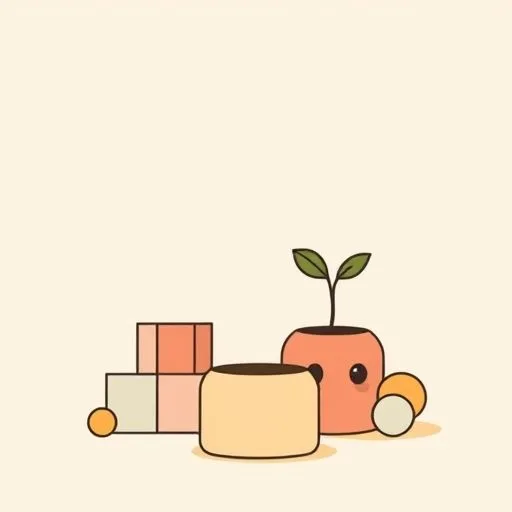
There’s something absolutely magical about watching a child’s flexible thinking in action! After our 100-meter school stroll, we gather for bibimbap drizzled with maple syrup, chatting about all the wild connections she noticed today. Just the other day, my daughter was connecting dots between her drawing class and the nature documentary we watched last weekend. She started sketching flowers with patterns inspired by butterfly wings, completely making those connections on her own! It made me think about how AI systems are now learning to do similar things – connecting different pieces of information to create something new and amazing.
So, how can we spark more of these magical moments?
How Can We Nurture Our Child’s Flexible Schema?

You know, I’ve been thinking about how children’s minds work differently from ours. They don’t organize information in neat, structured categories like we adults do. Instead, their minds are flexible, making connections we might never see! It’s like they have this natural ‘flexible schema’ – they can take ideas from completely different areas and blend them together in creative ways.
It reminds me of the time I caught my daughter mixing paint colors and shapes like a little data scientist—pure magic! Just like that, kids naturally absorb knowledge without worrying about proper categories. They see the world as one big, interconnected playground of ideas!
Our job as parents isn’t to force our children into rigid learning structures. Instead, we can nurture their natural ability to make connections. When my daughter builds with blocks and then incorporates those geometric patterns into her drawings later, that’s her brain doing exactly what AI systems are learning to do – finding relationships between different types of information. The flexible thinking that comes so naturally to children might just be the most valuable skill we can encourage in today’s rapidly changing world.
How Do We Bridge Different Worlds of Knowledge for Our Kids?

Have you ever watched your child make a connection that completely surprises you? That moment when they link something from school to a family conversation from weeks ago? Those are the golden moments of parenting!
This is exactly what happens when AI systems connect to different data sources. The latest tools help AI agents access information from various places and synthesize it in meaningful ways. Similarly, our children are constantly connecting their experiences – from playground games to classroom lessons to family stories.
Just like MCP Toolbox creates bridges between AI systems and databases, we parents create bridges between different areas of our children’s lives. When we encourage them to see connections between math and cooking, or art and science, we’re helping them develop this crucial skill for the future. This flexible thinking approach to learning prepares them for a world where information comes from everywhere and everything is interconnected.
I love how technology has made it easier for kids to explore different subjects. My daughter can watch a nature documentary one day, try a simple coding app the next, and then create a story that combines both elements! This natural integration of different knowledge areas is something we should celebrate and nurture.
Why Is Language So Important for Flexible Thinking?

What’s absolutely fascinating is how AI systems are now learning to understand our natural language to interact with data. They can answer questions and perform tasks based on spoken or written instructions rather than complex code!
Our children are natural language learners too! From the moment they start asking ‘why’ about everything, they’re engaging with the world through conversation. This back-and-forth is how they build understanding and make connections. As they develop their language skills, they’re also building the foundation for flexible thinking that will serve them throughout their lives.
When we talk with our kids about their experiences, ask open-ended questions, and really listen to their explanations, we’re helping them develop the language skills they’ll need to articulate their ideas clearly. This ability to communicate complex thoughts – whether to a parent, teacher, or future AI assistant – is going to be invaluable. The connection between language and flexible thinking is something we underestimate at our children’s peril.
I’ve found that the most powerful learning moments happen when we let our children lead the conversation. What if we just stopped talking and really listened to their unexpected insights? Sometimes, the most profound insights come from those bedtime discussions when they’re processing their day and making unexpected connections between different experiences.
How Can We Prepare Our Kids for a World Where Flexible Thinking Matters Most?

Let’s be honest – the future our children will navigate is going to look very different from the world we knew. AI will be part of their everyday lives, just like smartphones are part of ours today.
But here’s the exciting part: the skills that will help our children thrive aren’t technical skills, but human skills! Things like creativity, emotional intelligence, adaptability, and yes – the ability to make connections between different ideas. At the heart of all these skills is flexible thinking – the capacity to see beyond the obvious and find novel solutions.
When we encourage our kids to follow their curiosity, explore different interests, and see how everything is interconnected, we’re giving them tools that will serve them well regardless of how technology evolves. The ability to think flexibly, adapt to new situations, and find creative solutions to problems – these are the superpowers we can help our children develop.
I love watching my daughter approach problems from different angles. Sometimes her solutions are completely unexpected but brilliant! That flexible thinking, that ability to see multiple perspectives and connect different ideas – that’s exactly what will help her navigate whatever challenges come her way.
The most valuable connections we help our children make aren’t just between ideas, but between people. The ability to understand and connect with others – that’s something no AI can replicate, and it’s perhaps the most precious gift we can give our children.
How Can We Celebrate the Joy of Flexible Thinking in Our Children?

At the end of the day, what matters most is the joy of discovery – for both our children and for us! Whether it’s watching a child’s eyes light up when they make a new connection or seeing how AI systems can help us understand complex data better, there’s something incredibly exciting about these moments of insight. When we recognize and celebrate these moments of flexible thinking, we reinforce the very behaviors that will serve our children well.
Parenting is all about creating an environment where these connections can happen naturally. It’s about providing opportunities for exploration, asking thoughtful questions, and celebrating those ‘aha!’ moments when everything clicks into place. The flexible thinking we nurture today will become the innovative problem-solving of tomorrow.
Whenever you spot your child weaving ideas in ways you never expected, pause and celebrate that spark—it’s the true magic of flexible thinking.
Source: Simplify AI-Driven Data Connectivity With MongoDB and MCP Toolbox, MongoDB, 2025-09-22
